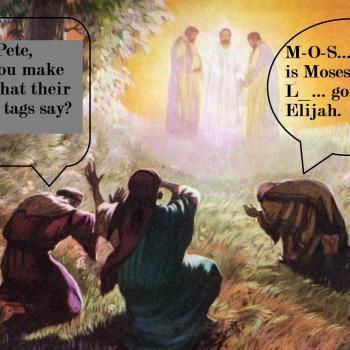I’m grateful to have been given the opportunity to participate in the blog tour about Bart Ehrman’s latest book, Did Jesus Exist?: The Historical Argument for Jesus of Nazareth
. Ehrman emphasizes that many mythicists appear to approach the question of Jesus’ existence in the manner of conspiracy theorists, and since such people refuse to change their minds, his book is not aimed at them. It is rather aimed at the genuine seeker after understanding. While a consensus among experts can be wrong, most people who are in their right minds grasp that such scholarly agreement is not to be ignored. His book aims to explain why that consensus exists, and to defend its conclusion from serious and not so serious attacks. Ehrman is emphatic about why he is doing so: because history matters, and those who deny that there was a historical Jesus do so not because a dispassionate consideration of the evidence leads to that conclusion, but because some other agenda drives them.
Not all versions of mythicism can be taken seriously enough even to merit a detailed response, Ehrman emphasizes. He nonetheless takes the time to point out what are not merely errors but howlers in the writings of Acharya S. (which he says seems like it could be a spoof of mythicism) and Freke and Gandy (pp.23-24,28-30). In addition to getting basic facts demonstrably wrong, they also simply make things up and make claims without citing actual evidence. And so most of the book focuses on mythicists whose writings Ehrman considers deserve a serious response: Richard Carrier, Robert Price, and Earl Doherty, among others.
There are two major parts to the book, only the first of which I will focus on in this post. But there are also two kinds of treatments of primary evidence which run throughout the book: (1) material which, when considered from the perspective of historical investigation, points to the existence of a historical Jesus, and (2) material which, even if the mythicists are right about it, is irrelevant to their case. In some instances, the two overlap. For instance, considering the evidence from Josephus, Ehrman responds to the argument of one of his own students which is sometimes quoted by mythicists, to the effect that the Testimonium Flavianum could have been forged by Eusebius. But Ehrman also points out that a completely fabricated Testimonium Flavianum is not evidence for mythicism, any more than forged Hitler Diaries are evidence for the non-existence of Hitler. It is the state of the positive evidence that matters, and that alone. That some evidence is unreliable or inauthentic is a common occurrence in history and neither here nor there.
When it comes to the Gospels, Ehrman considers both those within and those outside the New Testament. Ehrman responds to the dismissal of these sources by some mythicists on the grounds that they are written by Christians and therefore biased, which he likens to someone dismissing sources about American history written by Americans simply because they are liable to be biased in favor of America. The historian takes account of bias but does not ignore all sources just because they have a point of view. And when it comes to the Gospels, Ehrman points out that mythicists are often viewing those works as though they were from the outset what they only became later, namely Scripture. When they were composed, they were works seeking to persuade and communicate, not speak as though their authority would be indisputable.
The sheer number of sources that agree independently on the existence of the historical Jesus is impressive, Ehrman emphasizes. When one considers the sources of the works we have, canonical and extracanonical, their agreement on this matter points clearly in one direction. To cast doubt on this, one would have to envisage a unified authority structure in the Jesus movement able to accomplish such a conspiracy, when in fact the sources themselves highlight the diversity and competing visions within the movement. To suggest that these various authors and sources independently invented a historical Jesus, or that despite their divergent views they conspired together to do so, is (to put it charitably) less plausible than the explanation of this state of affairs accepted by all scholars and historians teaching at accredited institutions.
Ehrman addresses many other points, focusing not only on the evidence for the historical Jesus, but also the tactics mythicists use to try to neutralize that evidence. The mythicist suggestion that evidence that does not fit their desired conclusion might be an interpolation Ehrman characterizes (quite charitably, in my opinion) as “scholarship of convenience,” since it is a suggestion which is often not based on any evidence in the manuscripts we have (p.133). Before concluding this all too brief summary, let me note one more point that he makes. Mythicists often see significance in Paul’s relative silence about some points they expect him to have mentioned about the historical Jesus, were he aware of one. On the one hand, Ehrman notes that other New Testament authors of epistles, as well as similar authors from the slightly later patristic period, who clearly thought Jesus had appeared in history, nonetheless have similarly sparse mention of the details of Jesus’ life, beyond the crucifixion. And so to the extent that there is a (relative) “silence” it must be explained in some other terms, because it is widespread. But perhaps more importantly, the impression that Paul is leaving things out is only based on a perspective from a later time, having read the Gospels. And so it is inconsistent to dismiss later evidence from the Gospels as late invention that is of no historical value, and at the same time to suggest that Paul’s silence about those things indicates that there was no historical Jesus. Like mythicist arguments tend to be, this one is illogical and self-contradictory. Ehrman highlights these inconsistencies, irrelevancies and shortcomings with a treatment that is both pointedly precise and yet more patient and respectful in tone than the arguments Ehrman is dealing with often deserve.
Ehrman also addresses some of the claims of Richard Carrier, pointing out that if the term “brothers of the Lord” was used for Christians in general, that cannot be the sense in which Paul uses it in Galatians and other references to a group which is contrasted not with non-Christians but with other Christians such as Peter or the apostles. And so the meaning that fits is that Jesus’ actual family members were in view. Ehrman also points out the problems with Carrier’s attempts to appeal to earlier sources such as Daniel or the Servant Songs of Deutero-Isaiah which allegedly could have inspired the idea of a crucified Messiah (pp.167-170). But once again, Ehrman puts his finger on an irrelevancy in such mythicist arguments. If Christians turned to Scripture and found in them the basis for inventing the notion of a crucified Messiah, that still does not indicate that they invented Jesus, the person to whom they applied those texts. To claim that the use of Scripture in depicting an individual proves their ahistoricity is a blatant non sequitur which Ehrman addresses further in the second part of the book.
Ehrman’s book is incredibly rich in detail. It reflects his typical fairness, insight, and clarity. I know that many mythicists have already begun panning the book, even before reading it in at least some cases. There have been and will continue to be attempts at misrepresentation and distraction from the force of Ehrman’s points. My plea to those who hang out in circles in which mythicism is popular, and who have never investigated the issue but who might be inclined to join in that dismissal, reflects the fact that I was once a young-earth creationist. You are (as I was, back then) hearing one side of the story, one that does not represent what experts in the history of this period and the origins of this religious movement have to say. You may have been told that there is a worldwide conspiracy to suppress the truth – just as young-earth creationist are told about evolution. Please, I ask you, listen to what Ehrman, a renowned expert with relevant credentials and experience who is an agnostic with atheist leanings, has to say on this topic.
Part two of my review, focused on part two of the book, will follow later this week. Stay tuned!













